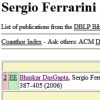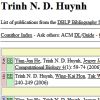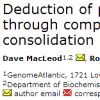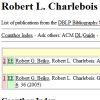| |
   
Bhaskar DasGupta,
Sergio Ferrarini,
Uthra Gopalakrishnan and
Nisha Raj Paryani. Inapproximability results for the lateral gene transfer problem. In Proceedings of the Ninth Italian Conference on Theoretical Computer Science (ICTCS'05), Pages 182-195, springer, 2005.
Keywords: approximation, from rooted trees, from species tree, inapproximability, lateral gene transfer, parsimony, phylogenetic network, phylogeny.
Note: http://www.cs.uic.edu/~dasgupta/resume/publ/papers/ictcs-final.pdf.
|
|
| |
|
| |
|
| |
|
| |
   
Trinh N. D. Huynh,
Jesper Jansson,
Nguyen Bao Nguyen and
Wing-Kin Sung. Constructing a Smallest Refining Galled Phylogenetic Network. In RECOMB05, Vol. 3500:265-280 of LNCS, springer, 2005.
Keywords: from rooted trees, galled tree, NP complete, phylogenetic network, phylogeny, polynomial, Program SPNet, reconstruction.
Note: http://www.df.lth.se/~jj/Publications/refining_gn3_RECOMB2005.pdf.
|
|
| |
   
Daniel H. Huson,
Tobias Kloepper,
Peter J. Lockhart and
Mike Steel. Reconstruction of Reticulate Networks from Gene Trees. In RECOMB05, Vol. 3500:233-249 of LNCS, springer, 2005.
Keywords: from rooted trees, from splits, phylogenetic network, phylogeny, reconstruction, split, split network, visualization.
Note: http://dx.doi.org/10.1007/11415770_18.
|
|
| |
|
| |
  
Jesper Jansson,
Nguyen Bao Nguyen and
Wing-Kin Sung. Algorithms for Combining Rooted Triplets into a Galled Phylogenetic Network. In SODA05, Pages 349-358, 2005.
Keywords: approximation, explicit network, from triplets, galled tree, phylogenetic network, phylogeny, polynomial, reconstruction.
Note: http://portal.acm.org/citation.cfm?id=1070481.
|
|
| |
 
Luay Nakhleh and
Li-San Wang. Phylogenetic Networks: Properties and Relationship to Trees and Clusters. In TCSB2, Vol. 3680:82-99 of LNCS, springer, 2005.
Keywords: cluster containment, evaluation, from clusters, from network, from rooted trees, phylogenetic network, phylogeny, polynomial, tree containment, tree-child network.
Note: http://www.cs.rice.edu/~nakhleh/Papers/LNCS_TCSB05.pdf.
|
|
| |
  
Rune Lyngsø,
Yun S. Song and
Jotun Hein. Minimum Recombination Histories by Branch and Bound. In WABI05, Vol. 3692:239-250 of LNCS, springer, 2005.
Keywords: ARG, branch and bound, from sequences, minimum number, Program Beagle, recombination, reconstruction, software.
Note: http://www.cs.ucdavis.edu/~yssong/Pub/WABI05-239.pdf.
|
|
| |
 
Magnus Bordewich and
Charles Semple. On the computational complexity of the rooted subtree prune and regraft distance. In ACOM, Vol. 8:409-423, 2005.
Keywords: agreement forest, from rooted trees, NP complete, SPR distance.
Note: http://www.math.canterbury.ac.nz/~c.semple/papers/BS04.pdf.
Toggle abstract
"The graph-theoretic operation of rooted subtree prune and regraft is increasingly being used as a tool for understanding and modelling reticulation events in evolutionary biology. In this paper, we show that computing the rooted subtree prune and regraft distance between two rooted binary phylogenetic trees on the same label set is NP-hard. This resolves a longstanding open problem. Furthermore, we show that this distance is fixed parameter tractable when parameterised by the distance between the two trees."
|
|
| |
   
Dave MacLeod,
Robert L. Charlebois,
W. Ford Doolittle and
Eric Bapteste. Deduction of probable events of lateral gene transfer through comparison of phylogenetic trees by recursive consolidation and rearrangement. In BMCEB, Vol. 5(27), 2005.
Keywords: explicit network, from rooted trees, lateral gene transfer, phylogenetic network, phylogeny, Program HorizStory, reconstruction, software.
Note: http://dx.doi.org/10.1186/1471-2148-5-27.
Toggle abstract
"Background: When organismal phylogenies based on sequences of single marker genes are poorly resolved, a logical approach is to add more markers, on the assumption that weak but congruent phylogenetic signal will be reinforced in such multigene trees. Such approaches are valid only when the several markers indeed have identical phylogenies, an issue which many multigene methods (such as the use of concatenated gene sequences or the assembly of supertrees) do not directly address. Indeed, even when the true history is a mixture of vertical descent for some genes and lateral gene transfer (LGT) for others, such methods produce unique topologies. Results: We have developed software that aims to extract evidence for vertical and lateral inheritance from a set of gene trees compared against an arbitrary reference tree. This evidence is then displayed as a synthesis showing support over the tree for vertical inheritance, overlaid with explicit lateral gene transfer (LGT) events inferred to have occurred over the history of the tree. Like splits-tree methods, one can thus identify nodes at which conflict occurs. Additionally one can make reasonable inferences about vertical and lateral signal, assigning putative donors and recipients. Conclusion: A tool such as ours can serve to explore the reticulated dimensionality of molecular evolution, by dissecting vertical and lateral inheritance at high resolution. By this, we mean that individual nodes can be examined not only for congruence, but also for coherence in light of LGT. We assert that our tools will facilitate the comparison of phylogenetic trees, and the interpretation of conflicting data. © 2005 MacLeod et al; licensee BioMed Central Ltd."
|
|
| |
   
Victor Kunin,
Leon Goldovsky,
Nikos Darzentas and
Christos A. Ouzounis. The net of life: Reconstructing the microbial phylogenetic network. In GR, Vol. 15:954-959, 2005.
Note: http://dx.doi.org/10.1101/gr.3666505.
Toggle abstract
"It has previously been suggested that the phylogeny of microbial species might be better described as a network containing vertical and horizontal gene transfer (HGT) events. Yet, all phylogenetic reconstructions so far have presented microbial trees rather than networks. Here, we present a first attempt to reconstruct such an evolutionary network, which we term the "net of life." We use available tree reconstruction methods to infer vertical inheritance, and use an ancestral state inference algorithm to map HGT events on the tree. We also describe a weighting scheme used to estimate the number of genes exchanged between pairs of organisms. We demonstrate that vertical inheritance constitutes the bulk of gene transfer on the tree of life. We term the bulk of horizontal gene flow between tree nodes as "vines," and demonstrate that multiple but mostly tiny vines interconnect the tree. Our results strongly suggest that the HGT network is a scale-free graph, a finding with important implications for genome evolution. We propose that genes might propagate extremely rapidly across microbial species through the HGT network, using certain organisms as hubs. ©2005 by Cold Spring Harbor Laboratory Press."
|
|
| |
|
| |

David A. Morrison. Networks in phylogenetic analysis: new tools for population biology. In IJP, Vol. 35:567-582, 2005.
Keywords: median network, NeighborNet, phylogenetic network, phylogeny, population genetics, Program Network, Program Spectronet, Program SplitsTree, Program T REX, Program TCS, reconstruction, reticulogram, split decomposition, survey.
Note: http://hem.fyristorg.com/acacia/papers/networks.pdf.
|
|
| |
   
Luay Nakhleh,
Tandy Warnow,
C. Randal Linder and
Katherine St. John. Reconstructing reticulate evolution in species - theory and practice. In JCB, Vol. 12(6):796-811, 2005.
Keywords: from rooted trees, galled tree, phylogenetic network, phylogeny, polynomial, Program SPNet, reconstruction, software.
Note: http://www.cs.rice.edu/~nakhleh/Papers/NWLSjcb.pdf.
|
|
| |
|
| |
   
Mihaela Baroni,
Stefan Grünewald,
Vincent Moulton and
Charles Semple. Bounding the number of hybridization events for a consistent evolutionary history. In JOMB, Vol. 51(2):171-182, 2005.
Keywords: agreement forest, bound, explicit network, from rooted trees, hybridization, minimum number, phylogenetic network, phylogeny, reconstruction, SPR distance.
Note: http://www.math.canterbury.ac.nz/~c.semple/papers/BGMS05.pdf.
Toggle abstract
"Evolutionary processes such as hybridisation, lateral gene transfer, and recombination are all key factors in shaping the structure of genes and genomes. However, since such processes are not always best represented by trees, there is now considerable interest in using more general networks instead. For example, in recent studies it has been shown that networks can be used to provide lower bounds on the number of recombination events and also for the number of lateral gene transfers that took place in the evolutionary history of a set of molecular sequences. In this paper we describe the theoretical performance of some related bounds that result when merging pairs of trees into networks. © Springer-Verlag 2005."
|
|
| |
  
Barbara R. Holland,
Frédéric Delsuc and
Vincent Moulton. Visualizing Conflicting Evolutionary Hypotheses in Large Collections of Trees: Using Consensus Networks to Study the Origins of Placentals and Hexapods. In Systematic Biology, Vol. 54(1):66-76, 2005.
Keywords: consensus.
Note: http://hal-sde.archives-ouvertes.fr/halsde-00193050/fr/.
Toggle abstract
"Many phylogenetic methods produce large collections of trees as opposed to a single tree, which allows the exploration of support for various evolutionary hypotheses. However, to be useful, the information contained in large collections of trees should be summarized; frequently this is achieved by constructing a consensus tree. Consensus trees display only those signals that are present in a large proportion of the trees. However, by their very nature consensus trees require that any conflicts between the trees are necessarily disregarded. We present a method that extends the notion of consensus trees to allow the visualization of conflicting hypotheses in a consensus network. We demonstrate the utility of this method in highlighting differences amongst maximum likelihood bootstrap values and Bayesian posterior probabilities in the placental mammal phylogeny, and also in comparing the phylogenetic signal contained in amino acid versus nucleotide characters for hexapod monophyly. Copyright © Society of Systematic Biologists."
|
|
| |
   
Martyn Kennedy,
Barbara R. Holland,
Russel D. Gray and
Hamish G. Spencer. Untangling Long Branches: Identifying Conflicting Phylogenetic Signals Using Spectral Analysis, Neighbor-Net, and Consensus Networks. In Systematic Biology, Vol. 54(4):620-633, 2005.
Keywords: abstract network, consensus, NeighborNet, phylogenetic network, phylogeny.
Note: http://awcmee.massey.ac.nz/people/bholland/pdf/Kennedy_etal_2005.pdf.
|
|
| |
    
Richard C. Winkworth,
David Bryant,
Peter J. Lockhart,
David Havell and
Vincent Moulton. Biogeographic Interpretation of Splits Graphs: Least Squares Optimization of Branch Lengths. In Systematic Biology, Vol. 54(1):56-65, 2005.
Keywords: abstract network, from distances, from network, phylogenetic network, phylogeny, reconstruction, split, split network.
Note: http://www.math.auckland.ac.nz/~bryant/Papers/05Biogeographic.pdf.
|
|
| |
  
Insa Cassens,
Patrick Mardulyn and
Michel C. Milinkovitch. Evaluating Intraspecific Network Construction Methods Using Simulated Sequence Data: Do Existing Algorithms Outperform the Global Maximum Parsimony Approach? In Systematic Biology, Vol. 54(3):363-372, 2005.
Keywords: abstract network, evaluation, from unrooted trees, haplotype network, parsimony, phylogenetic network, phylogeny, Program Arlequin, Program CombineTrees, Program Network, Program TCS, reconstruction, software.
Note: http://www.lanevol.org/LANE/publications_files/Cassens_etal_SystBio_2005.pdf.
|
|
| |
|
| |
   
Charles Choy,
Jesper Jansson,
Kunihiko Sadakane and
Wing-Kin Sung. Computing the maximum agreement of phylogenetic networks. In TCS, Vol. 335(1):93-107, 2005.
Keywords: dynamic programming, FPT, level k phylogenetic network, MASN, NP complete, phylogenetic network, phylogeny.
Note: http://www.df.lth.se/~jj/Publications/masn8_TCS2005.pdf.
Toggle abstract
"We introduce the maximum agreement phylogenetic subnetwork problem (MASN) for finding branching structure shared by a set of phylogenetic networks. We prove that the problem is NP-hard even if restricted to three phylogenetic networks and give an O(n2)-time algorithm for the special case of two level-1 phylogenetic networks, where n is the number of leaves in the input networks and where N is called a level-f phylogenetic network if every biconnected component in the underlying undirected graph induces a subgraph of N containing at most f nodes with indegree 2. We also show how to extend our technique to yield a polynomial-time algorithm for any two level-f phylogenetic networks N1,N2 satisfying f=O(logn); more precisely, its running time is O(|V(N1)|·|V(N2)|·2f1+f2), where V(Ni) and fi denote the set of nodes in Ni and the level of Ni, respectively, for i∈{1,2}. © 2005 Elsevier B.V. All rights reserved."
|
|
| |
 
Dan Gusfield and
Dean Hickerson. A Fundamental, Efficiently-Computed Lower Bound on the Number of Recombinations Needed in Phylogenetic Networks. 2004.
Note: UC Davis Computer Science Technical Report.
|
|
| |

Luay Nakhleh. Phylogenetic Networks. PhD thesis, University of Texas at Austin, U.S.A., 2004.
Keywords: distance between networks, evaluation, generation, phylogenetic network, phylogeny, Program SPNet, reconstruction, split, statistical model, tree sibling network.
Note: http://www.library.utexas.edu/etd/d/2004/nakhlehl042/nakhlehl042.pdf.
|
|
| |
|
| |

Mihaela Baroni. Hybrid phylogenies : a graph-based approach to represent reticulate evolution. PhD thesis, University of Canterbury, New Zealand, 2004.
Keywords: explicit network, from rooted trees, galled tree, hybridization, minimum number, phylogenetic network, phylogeny, reconstruction, regular network.
Note: http://ir.canterbury.ac.nz/bitstream/10092/4803/1/baroni_thesis.pdf.
|
|
| |
 
Jesper Jansson and
Wing-Kin Sung. Inferring a level-1 phylogenetic network from a dense set of rooted triplets. In COCOON04, Vol. 3106:462-471 of LNCS, springer, 2004.
Keywords: explicit network, from triplets, galled tree, level k phylogenetic network, phylogenetic network, phylogeny, polynomial, reconstruction.
Note: http://www.df.lth.se/~jj/Publications/ipnrt6_COCOON2004.pdf.
|
|
| |
|
|